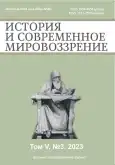Reform of the Soviet Armed Forces during the Khrushchev Thaw (1953–1964)
- 作者: Shunyakov D.V.1, Zapariy V.V.1
-
隶属关系:
- Ural Federal University named after the First President of Russia B. N. Yeltsin
- 期: 卷 5, 编号 3 (2023)
- 页面: 59-67
- 栏目: HISTORY OF RUSSIA
- URL: https://journals.eco-vector.com/2658-4654/article/view/623856
- DOI: https://doi.org/10.33693/2658-4654-2023-5-3-59-67
- ID: 623856
如何引用文章
详细
The experience of military reform of the Soviet Armed Forces during the years of N.S. Khrushchev at the head of the Soviet Union is analyzed. It is stated that a radical change in the geopolitical situation required the reorganization of the Armed Forces, which passed two stages of military construction. During the first stage, which took place in 1953–1959. The Soviet government took peaceful initiatives to reduce military-political escalation, formed a military-political bloc. The Warsaw Pact Organization, as a counterweight to NATO, saw a significant reduction in the number of armed forces, created nuclear parity with the United States. During the second stage (1960–1964), it was supposed to sharply reduce the number of armed forces and return to the police recruiting system that existed in the USSR in the 1930s. Due to the sharp aggravation of the international situation, these plans had to be abandoned, the usual means of armed struggle received a sharp impetus for development. N.S. Khrushchev's radical reforms were shown to antagonize the military leadership, leading to the latter's support for his resignation in October 1964.
关键词
全文:
作者简介
Dmitry Shunyakov
Ural Federal University named after the First President of Russia B. N. Yeltsin
Email: konigsberg039@mail.ru
Cand. Sci. (Hist.), Professor of the Department of Engineering Troops of the Military training Center
俄罗斯联邦, YekaterinburgVladimir Zapariy
Ural Federal University named after the First President of Russia B. N. Yeltsin
编辑信件的主要联系方式.
Email: v.v.zaparij@urfu.ru
ORCID iD: 0000-0002-3326-4796
Dr. Sci. (Hist.), Professor, Honored Worker of the Higher School of the Russian Federation; Professor of Department of Russian Histo
俄罗斯联邦, Yekaterinburg参考
- Bystrova N.E. Of the USSR and the formation of a military-bloc confrontation in Europe (1945–1955). M.: Hyperborea. Kuchkovo field, 2007. 592 p.
- Navy Chief Staff: History and Modernity. 1696-1997. M.: Scientific book, 1998. 186 p.
- History of the military strategy of Russia/edited by V. A. Zolotarev. M.: Kuchkovo field; Polygraphresurs, 2000. 592 p.
- Kuznetsov N.G. «Our relationship with Zhukov has become truly dramatic» ... / Publ. V.N. Kuznetsova, Yu.K. Lugovoy // Military History Journal. 1992. № 1. Рр. 74–82.
- Lashkov A.Yu., Golotyuk V.L. 100 years of the Russian Air Force (1912–2012). M.: Foundation «Russian Knights», 2012. 792 p.
- On guard of the borders of the Fatherland. History of Border Patrol. Brief essay. M.: Border, 1998. 607 p.
- From the internal guard of the Russian Empire to the troops of the National Guard of the Russian Federation / under the general. ed. V.V. Zolotova. M.: Ed. magazine. «At the Battle Post», 2019. 160 p.
- Pervov M. Missile systems of the Strategic Missile Forces // Equipment and weapons. 2001. № 5–6. 88 p.
- Born of the atomic era: in 2 t. T. 1. History of creation and development 12 Main Directorate of the Ministry of Defense of the Russian Federation/edited by I.N. Volynkina. M.: Science, 2007. 376 p.
- Feskov V.I., Golikov V.I., Kalashnikov K.A., Slugin S.A. Armed Forces of the USSR after World War II: from the Red Army to the Soviet. Tomsk: TSU Publishing House. 640 p.
- Hupenen A.I. Historical experience in the development of the Air Defense Forces: from a stuffy defense to the Aerospace Forces of Russia // Information and methodological collection of the Central Museum of the Armed Forces of the Russian Federation. 2017. №1 (35). Pр. 22–29.
- Shunyakov D.V., Zapary V.V. Reorganization of the structure of the central governing bodies of the Soviet Armed Forces after the end of World War II (1945–1953) // History and modern worldview. 2023. T. 5. № 1. Pр. 48–53.
补充文件










